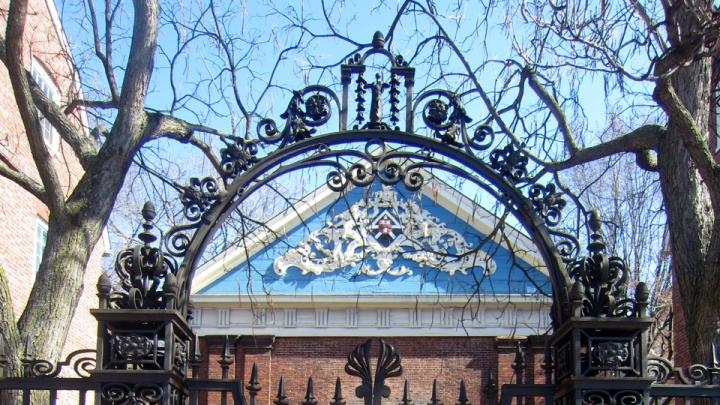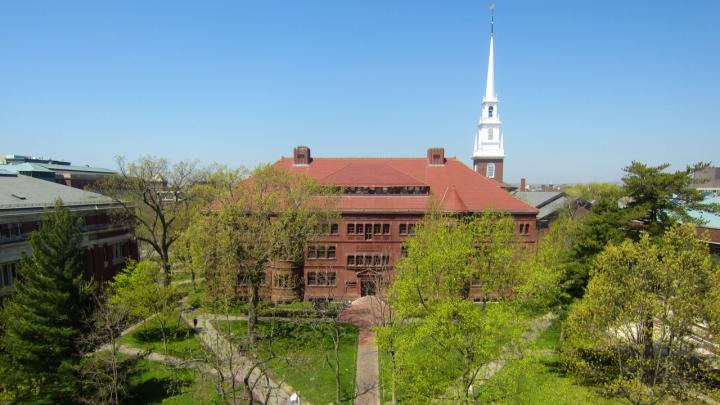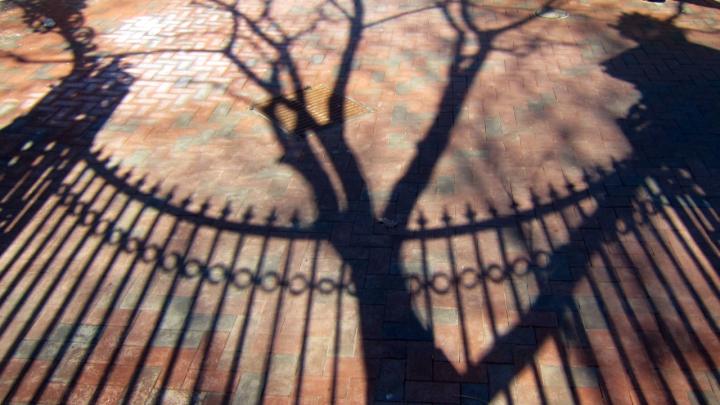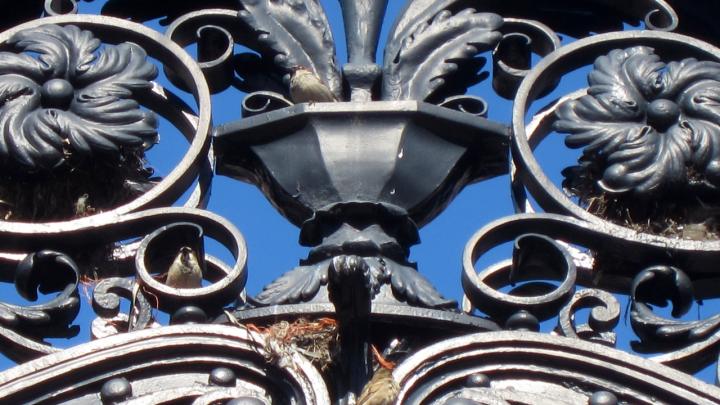When Pulitzer-Prize winning author and Chicago Tribune architecture critic Blair Kamin arrived in Cambridge last August, he had no idea what his Nieman Fellowship year would bring. As he walked around Harvard’s campus, the beauty of the Yard’s 25 wrought-iron gates immediately struck him. Yet questions also flooded his mind: What did the numbers on them mean? Who paid for them? Why were they installed in the first place? “I was curious,” Kamin recalls. “Being a visual person, I just kept noticing them, and all their rich detailing.”
In September, Nieman curator Ann Marie Lipinski asked if several of the fellows would be willing to get together and teach a January-term intensive class for undergraduates. Kamin suggested doing the class on the gates: having students look at them, study them, and go into the archives to dig out their backstories.
That class’s research has now turned into an e-book, The Gates of Harvard Yard: The Complete Story, in Words and Pictures, of a Great University’s Iconic Portals, that explores the gates’ history, design, and present state: “a mix of glory and neglect,” according to Kamin. The book—the first fully-designed e-book ever published by the Nieman Foundation—is available for download in the iTunes store.
Below, Harvard Magazine talks with Kamin about his experience delving into the rich history of these gates, and about what he and his students have learned throughout this process.
HM: Where did you start with your research? Did you hit any roadblocks early on?
BK: The research started in two ways: the first was just looking. Most people don’t look at the gates; they just pass through them and never really stop and notice. That’s the most important thing: you have to slow down, stop, and look. That involved a lot of photography with the digital cameras, just to start recording all these details, and the way the gates worked together. The other key step was going into Pusey Library, to the [Harvard University]Archives. I was very lucky to work with [public services archivist] Barbara Meloni, who expertly directed us to archival material about all the gates. I knew, going in, that the students would have lots of stuff to chew on and investigate. They came up with some amazing stuff as a result.
HM: Were the students excited by this project?
BK: [The students] were an incredibly talented, passionate, hardworking group, and were very much self-selected. Giving up eight days of January term when your friends are on the beach in Miami, and working in the winter in Harvard, going outside on a 20-degree day and counting the number of people that walked through the gates, being in the archives, is not exactly light duty, but the students did wonderful work. That is what inspired the e-book. I thought, “No one has really ever done this.” There have been essays, overview essays, on the gates, but no one had ever gone into the archives before and thoroughly investigated each and every gate, and also critiqued the gates. We posted the stories on a website, but it was graphically underwhelming, done quick and dirty, and we wanted to tell a visual story. If it was going to live on, it demanded a more visually attractive treatment. That is what gave birth to the push for the e-book.
HM: Are those the main benefits, do you think, of this medium for this kind of topic?
BK: The idea for the e-book actually came from James Geary, the deputy director of the Nieman Foundation. Also, Barbara McCarthy, the graphic designer for the Nieman Foundation, investigated different formats. We quickly settled on iTunes because it offered us the most flexible, innovative format. We were able to incorporate more than 130 contemporary still photographs, more than 20 iPhone panoramas, 20-plus archival photographs, an interactive glossary, and many other features that really explore the frontier of architectural publishing. The result is a very sophisticated, multilayered treatment that you just can’t do on a simple Kindle format.
HM: How did you manage to see these gates with fresh eyes?
BK: I think that being open to them and their traditional architecture is the most important thing. There is a tendency at Harvard and its Graduate School of Design to focus on modern architecture. The school leans strongly in that direction. Traditional architecture like this is often either ignored or put on the back burner. It was important to be open to the beauty of the gates. I didn’t ideologically dismiss [them]. I saw them as part of the present, not just antiquated relics of the past. Also, the students were charged with bringing their stories to life by doing the archival research. For example, the famous Dexter Gate. [Its inscription] “Enter to grow in wisdom” is enlivened by the fact of its backstory. Who was Samuel Dexter? We know from the inscription, the plaque on the gate, that he died four years after he graduated from Harvard, but what was his story? Well, the student researching that gate found out that he was a very popular and accomplished member of his class.
He was described in his Crimson obituary as one of the most promising recent graduates of Harvard. He was a member of Hasty Pudding, the A.D., and the varsity football team. He suffered from cerebrospinal meningitis. At the same time, Becca Mazur [ ’15], the student who researched this gate, discovered that Harvard president [Charles William] Eliot, who penned [the two quotations inscribed on the gate], considered alternative versions.
For example, instead of, “Enter to grow in wisdom,” the quote facing Massachusetts Avenue might have read, “Enter daily to grow in wisdom,” which sounds prescriptive rather than Olympian. Similarly, the reverse side of the gate says, “Depart to serve better thy country and thy kind,” and it could have read, “Depart to serve better thy country and mankind.” “Mankind” would have been entirely a different meaning, because “thy kind” has this strange elitist connotation to it. It sounds like you’re supposed to depart Harvard to serve better your fellow white males who attended this elite institution, but of course “thy country and thy kind” has a nice alliteration to it.
There are many other things that brought the gates into the present. Another outstanding essay is by Lily Sugrue [’16], who wrote about the Class of 1870 Gate. This is a gate on the northwest side of the Yard. It’s a beautiful, delicate gate that has an arch almost like an eyebrow that frames Holden Chapel. The gate was designed to be open. We have archival photographs showing it open and acting as a wonderful threshold to a plaza with a sundial, and then Holden Chapel behind it. Now it’s locked, and has been for decades. It really prevents pedestrians from entering this wonderful courtyard. The gate needs a Mary Lennox to open it, to unlock the [secret] garden.
One of the wrought-iron leaves on the gate had cracked and was poised to break off. On my last day in Cambridge, I dropped by this gate, because I’d always wondered what was going to happen to those leaves that were breaking. I noticed the leaf was gone. Sure enough, at the bottom of the wrought-iron column was this fragment that had broken off. I was aghast because Harvard is letting this gate, and many of the other gates, just fall apart.
It’s absolutely unconscionable, the neglect that’s going on. This presented me with a real quandary. Journalists aren’t supposed to enter the story, but on the other hand, if I didn’t do something, this beautiful piece of wrought iron would be swept away by the wind, or an animal, or taken away by some tourist. I picked it up and brought it to the office of Lori Gross, the associate provost for arts and culture, who I knew would be a good caretaker for it, and would bring it to the attention of the Campus Services people who are responsible for maintaining the Yard.
This was, again, something that brought the gates into the present. They aren’t frozen in time. They need lots of tender loving care. In some cases, at least, they aren’t getting it. Another really disturbing example is the Classes of 1887 and 1888 Gate, across Broadway from Memorial Hall. It’s a semi-circular gate that is unique among the Yard’s gates because it’s a double gate and the only gate that was sponsored by two classes. At the center of the gate, there was a sculpted lion’s face that had water coming out of its mouth and going into a fountain, a basin. Now, the basin is full of trash.
The other issues that the class raised have to do with whether certain gates should be unlocked. That seems very much a live issue because President Faust has argued for one Harvard and the importance of common spaces, where people from different parts of Harvard can come together. The gates are not simply [part of] a border that encircles the art, but rather they’re portals that focus attention on the art of common spaces. The e-book argues that these gates—some of the gates, at least—should be unlocked and opened in order to revitalize these common spaces.
Another issue has to do with names. Harvard, for decades now, has persisted in mislabeling the gates. For example, it calls the gates not by the names of classes that donated the money [to erect them], but rather by the buildings that they’re next to.
HM: What surprised you most about doing this project?
BK: The beauty of the gates themselves—they are a visual treasure trove. Because I was photographing the gates for several months, I kept going back to them, and in a variety of ways, details would emerge that I hadn’t seen [before]. In the gate named for President Eliot, along Quincy Street, there’s a little pilgrim’s hat inserted in the wrought iron. It’s a whimsical tribute to Eliot’s Puritan forebears. The Class of 1857 Gate, right across from Holyoke Center, is this triple-arched gate that scores of people walk through in any given hour. That one is fascinating because that class was a Civil War class, and members of the class were killed on both sides of the fight in the Civil War. It becomes a very touching memorial to the unbroken bonds of friendship that this class had.
The gates act as a kind of family, a group of siblings that are related in the way they look, and their materials, and their aesthetics. Yet, they are like siblings—all different. [They] create this scrim of unity that, joined with buildings like Wigglesworth, create an impression of harmony and order for the passersby along Massachusetts Avenue.
And even though the gates are on the margins of the Yard, they’re actually central to Harvard’s architectural identity because Johnston Gate, in particular, turned the University away from the high Victorian Gothic aesthetic of Memorial Hall. The gates’s color and very picturesque aesthetic brought [Harvard] back to something much more modest and simple, the Georgian style of Massachusetts Hall. This really set the tone for Harvard’s architecture for the next half-century. It influenced the River Houses, the Weeks Bridge, and the Business School.
All these things really grow from DNA that was developed in the gates. While the gates were relatively small, smaller than buildings, they have had an enormous impact. That’s why I think that their beauty and these issues that relate to their neglect, or how they’re managed, make them not just historical curiosities, but very much alive and part of the present, and worth thinking about today.














